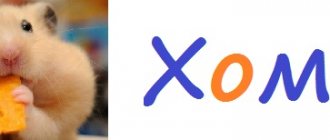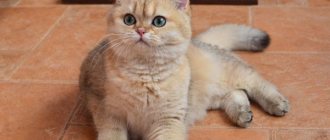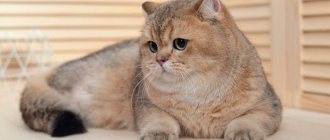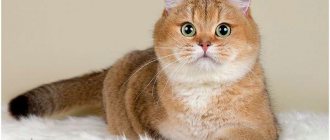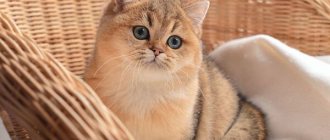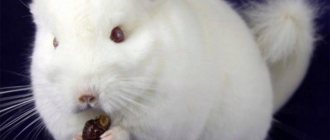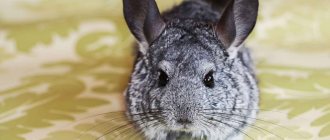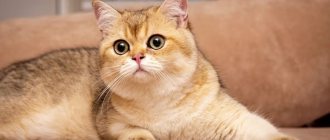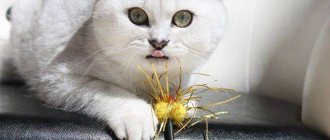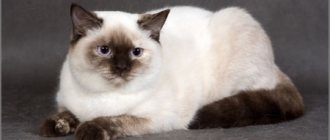The gorgeous golden color of these cats and their soft plush coat are eye-catching. For those who are interested in the breed and are already thinking about finding a kitten, it is worth mentioning that the golden chinchilla (golden chinchilla) is a color that is found in several cat breeds.
British golden chinchilla (BRI-ny12)
A little about the appearance of the precious rock
The first birth of a chinchilla cat occurred in the 80s. 19th century in America. A simple smoky cat and a silver tabby gave the world beautiful babies with iridescent gray fur, who were given the name chinchilla.
This unique coat color instantly found its fans, and later the breeders worked with inspiration so that in addition to the silver chinchilla, a golden chinchilla would be born.
The painstaking work bore fruit already in the 30s. In the 20th century, the number of chinchillas increased, thereby securing the result obtained. At the same time, the golden chinchilla cat breed is born less often, and therefore is valued an order of magnitude higher.
Origin story
The breed of Scottish chinchillas is considered young, the color is artificially bred, it originated from long-haired Persians. The color, as well as the behavior of the animals themselves, is in many ways similar to their British relatives. During the development of the breed, to expand the gene pool, breeders took British cats for mating, including individuals with chinchilla color. The bred cats borrowed the name “chinchilla” from the color of small rodents.
The family tree of Scots with chinchilla coats dates back to 1959, when a small kitten with floppy ears was born on one of the Scottish farms and was named Susie. His mother was a British cat. After some time, the kitten went to the breeders William Ross and his wife Mary, who specialized in breeding British cats.
In 1691, as a result of selection, the fold-eared cat gave birth to its own baby, who was given the name Snooks. 5 years later (in 1966) the breed was officially registered with the GCCF. As a result of selection, not only fold-eared kittens (Scottish Fold), but also straight-eared kittens (Scottish Straight) were born.
The breeders also mated two lop-eared individuals, but as a result, babies were born with diseases of the musculoskeletal system. The bones of the skeleton also suffered from such a mutation, as a result of which the joints became thicker and short, and the spine also fused together.
For this reason, felinologists decided not to breed the breed. Therefore, breeders at one time were engaged in breeding straight-eared Scots. A little later, geneticist Neil Todd became involved in the breeding work, who, together with other breeders, eliminated the negative consequences of breeding the breed, while maintaining the folded ears. The solution to the problem was the selection of individuals for mating: folds began to be crossed with strikes. This is how the Scottish chinchilla appeared, which is still the reference standard of the breed.
European breeding was based on mating with British shorthairs, which is why these representatives of the cat family have a more massive skeleton and large ears that are not particularly pressed to the head. Cats were admitted to exhibitions already in 2004, and it is still prohibited to cross two fold-eared individuals.
Excellent appearance
Initially, the chinchilla color was applied exclusively to Persian cats, but from about the end of the 1970s. it is used to name British and exotic purrs. Despite belonging to different breeds, chinchilla cats have similar external characteristics:
- Weight – cat – up to 5 kg, cat – up to 7 kg.
- Body – has a compact size with a straight back and a broad, raised chest. The overall lines and contours of the body are beautiful and soft.
- The head is small in size, the skull protrudes slightly, the jaws are clearly visible. The distance between the rounded ears is large.
- The nose is upturned and short. The lobe can be soft pink or a darker, brick color, with a dark outline running along the contour.
- The eyes are located far from each other and are rather large in size. There must be dark eyeliner edging the eye. The shade is deep and rich, matching the tone of the coat. The golden chinchilla has green eyes, and in rare cases copper eyes.
- The paws are powerful, rounded and short. The pads are dark in color and have tufts of hair between the toes.
- The tail is well-furred and straight, with longer hair than on other parts. The size is short.
- The hair of Persians is long, fluffy and thick; the British will have it shorter, but also thick and very dense.
- Golden color is a rare combination of two shades. The golden apricot coat is combined with a darker, light chocolate undercoat, which stands out brightly on the paws, head and tail. Also, unlike silver chinchillas, golden ones do not have black eyeliner, but dark brown.
Description of the breed and requirements for the standard
According to the golden chinchilla standard, there is a lack of uniformity. They are assessed in accordance with the rules created for the respective cat breed. Therefore, for example, Persian and British representatives will have their own breed characteristics.
The golden chinchilla of the British breed is massive, muscular and compact in size. These cats are medium to large in size. The animals' limbs are squat and dense, and their paws are rounded.
The tail is short, quite thick and curved upward. British chinchilla cats have a plush coat, outwardly dense rows of fine hairs should make up a coat with iridescence.
The head of these representatives is round and very massive, and the neck is short and muscular. The muzzle has a well-prominent chin and a straight nose. These cats are distinguished by widely spaced emerald eyes and spread round ears.
The presence of two subtypes distinguishes the Scottish chinchilla cat. The first version of the Scottish Fold is distinguished by the fact that the tips of its compact ears are inclined forward and downward. This variety is also notable for its thicker cheeks and short, thick legs. Another type of Scottish Straight has medium-sized limbs, as well as ears, which are larger than those of Scottish Fold cats.
Character
The chinchilla cat breed of any coat color variation has a wonderful character, but there are differences between the breed variants.
The Persian chinchilla is an extraordinary and charming purr that loves to explore everything. Her playful disposition will be loved by her equally energetic and cheerful owners, to whom she becomes quite attached and can lie on someone’s lap for hours.
It is very important to give your pet some of your free time - different games with paper bows, toy mice and bones will cheer everyone up and protect the purr from obesity.
The smallest members of the household will find a wonderful play partner in the face of the Persian chinchilla. But the cat will not give in to all the child’s whims and will simply leave at the right moment. The purr will not offend the baby.
The chinchilla Persian rarely finds common ground with other pets - such a wayward aristocrat.
The British chinchilla cat breed has a different character. This sophisticated lady is affectionate, calm and very talkative. Happy purring and meowing is her method of communicating with her household.
But at the same time, British chinchillas value their personal space. They will not lie in the owner’s arms for a long time, allowing themselves to be squeezed. In general, this cat does not favor excessive tenderness.
As for training, the British chinchilla easily masters the established rules and, with a special approach, can master basic commands. Her intelligence level is above average; the main thing is that the mannered pet is in the right mood.
The Golden Briton socializes very quickly and no aggression is observed in her behavior. He treats strangers and children calmly, but is a little cautious. She sees other animals as competitors in her place, so she simply ignores them.
One color, gold, but the differences between British and Persian women are significant.
Origin story
It is believed that the gold and silver colors of British chinchillas were artificially bred by breeders by crossing Persians with Britons.
Today there are several plausible versions of the origins of the British with this color. Some sources say that the golden color was first obtained by English breeders, while others emphasize that American breeders and felinologists participated in the development of the color.
Among the numerous origin stories, we can only draw one conclusion: thanks to the long-term and painstaking work of professionals, such a luxurious coat color was obtained that can be admired to this day. At the same time, British chinchillas have good health and immunity, and also have a very gentle character.
Care
Any chinchilla needs proper care:
- Grooming. Both Persians and British Shorthairs need to be brushed twice a week using a Furminator. First they go through the hair growth, and then vice versa. During molting, pets are combed daily. At the same time, Persians need to be examined for the presence of tangles; if they appear, they need to be cut off.
- Face care. Use a damp cloth to clean the muzzle of any dirt. The eyes are wiped with a damp cotton pad (as a preventive measure, instead of water, the swab is moistened with a weak solution of boric acid), and the ears are regularly inspected and cleaned with a cotton swab dipped in Vaseline oil.
- Cat manicure. Claws are trimmed 1-2 times a month. But it is also desirable that the pet has its own secluded corner with a scratching post.
- Water procedures. Chinchillas generally do not like to bathe, so the best solution is to use a suitable dry shampoo.
- Walks. An optional, but still enjoyable event for the cat. The best option is to previously train your pet to wear a harness and use a flea and tick collar. Walking with these two items will keep your pet safe, and the overall process and sense of spaciousness will definitely please him.
Castration and sterilization of British chinchillas
At what age is it recommended to have surgery?
The procedure is done upon reaching 8 months. Before the operation, a consultation with a veterinarian is necessary, who will examine the pet and make a conclusion about its health.
Caring for your pet after surgery
After the castration operation is completed, your pet must be constantly monitored. Competent care consists of the following points:
- Limit physical activity.
- Ensure silence in the house.
- Do not give food for 8 hours after removal of the genitals.
- Purchase and put a special collar on the animal to avoid licking the wound.
- Regularly treat the seam with hydrogen peroxide.
Diet
The golden chinchilla is a cat breed that requires high-quality premium food. There is another option when the pet eats natural food, but with the addition of vitamins.
This natural diet should include the following foods:
- Dietary meat, chicken and offal (necessarily boiled).
- Boiled sea fish (replace meat with it several times a month).
- Soft-boiled eggs (give your pet 2 times a week).
- Low-fat sour milk.
- Vegetables, root vegetables, herbs, cereals and crackers. (mix them with protein foods).
- Pure water
Health
Both British and Persian chinchilla breeds require the attention of their owners. Competent care and thoughtful nutrition in most cases guarantee that a cat will live 12-15 years.
It is very important to regularly take your pet for veterinary examinations, because... There are some diseases characteristic of chinchillas. These are polycystic kidney disease, cardiovascular diseases and retinal atrophy.
It is also necessary to ensure that cats do not develop caries; to do this, accustom your cat to brushing its teeth from early childhood.
British
British chinchillas are usually smaller. They ripen late - full formation of the exterior is completed by 3 years.
The wool has a soft and silky texture. There are 2 varieties: British shorthair and longhaired chinchillas. The latter have elongated fur, which is inherited from Persian cats.
The most common are golden chinchillas with green eyes, but there are cats with blue and yellowish irises.
Purebred kitten - choose the right one
You should approach the purchase of a golden chinchilla baby responsibly. The price for a show class furry can reach up to $1000. Therefore, choose trusted breeders.
The rare golden color of the chinchilla is highly unstable, so look at the parents of the little miracle. The ideal shade of fur is obtained by mating identical individuals.
Observe the kitten's behavior before purchasing. From an early age they should be active, playful and inquisitive. Healthy babies have clean eyes and ears, and shiny fur.
The baby's parents should also show interest in what is happening, and not lie on one side. Also pay attention to their grooming.
Be sure to talk to the breeder about vaccinations, diet and general health of the baby. Check that you have all the documents and get ready to make your new family member happy.
Genetics of color
A polygenic complex is responsible for the golden chinchilla color, providing a warm shade of the undercoat and a lightened background color:
- melanin inhibitor – absorbs hair pigment, starting from the hair root;
- agouti and tabby (tabby) - forms a pattern;
- erizer – gene eraser, gives the undercoat a warm shade.
The golden chinchilla color includes several varieties depending on the color of the hair tips:
- black;
- chocolate;
- lilac;
- faun (fawn);
- cinnamon (cinnamon);
- blue.
The golden color is a recessive trait in relation to the silver color. Kittens of this color can be obtained in the following cases:
- both manufacturers have a golden color;
- parents are silver chinchillas, but are carriers of the golden gene;
- one producer is golden, the second is silver, but his genotype contains genes for goldenness.
